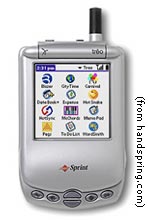NEW YORK (CNN/Money) -
Palm Inc. has agreed to buy Handspring Inc. for about $169 million, the companies said Wednesday, ending years of speculation that the two handheld device makers would merge.
The deal will not be completed until the fall and will happen only after Palm spins off its software unit, PalmSource. Handspring shareholders will receive 0.09 share of Palm stock for each share of Handspring they own, the companies said.
If the deal were done Wednesday, with Handspring shareholders getting 13.9 million Palm shares at $12.15 apiece, it would be worth $168.9 million. But the price will not be set until after the PalmSource spinoff, which will not take place until the fall.
 |
|
| Palm's Tungsten |
Handspring (HAND: Research, Estimates) shares surged 16 cents, or 14.4 percent, to $1.27, Wednesday morning. Palm (PALM: up $1.74 to $13.89, Research, Estimates) stock also jumped about 10 percent. Typically, the stock of an acquiring company goes down when a deal is announced.
Handspring was formed in 1998 by Jeff Hawkins, Donna Dubinsky, and Ed Colligan, who in 1992 had founded Palm and boosted the popularity of its best-selling Palm Pilot devices. Rumors of a potential reunion between the two companies have floated through Wall Street ever since.
Though both companies have struggled in recent years, they hope the merger will help them better take advantage of the Palm Pilot devices, Handspring's popular Treo -- a "smart phone" that combines handheld computing and mobile phone technology -- and the long institutional memory both firms enjoy.
 |
|
| Handspring's Treo 300 |
"The strategic choice of merging Handspring and the Palm Solutions Group of Palm will create the broadest portfolio and the most-experienced leadership team in the industry, fully capable of delivering value to customers, partners and shareholders," Palm CEO Eric Benhamou said in a statement.
The merged company, which will be renamed later this year, will generate cost savings of about $25 million a year, the companies said, assuming layoffs of about 125 people, the elimination of some programs, and the sale of some real estate.
The combined company will be based in Palm's Milpitas, Calif., headquarters and will be led by Palm Solutions CEO Todd Bradley.
The combined company had a 38.9 percent share of the handheld market in the first quarter, according to figures from research firm IDC. Palm was already the market leader in handhelds in the first quarter, with a 36 percent share, while Handspring ranked seventh, with only a 2.9 percent share. So the deal should not raise any major antitrust concerns.
But competitive challenges lie ahead, including increased competition from computer makers.
Hewlett-Packard (HPQ: up $0.58 to $20.65, Research, Estimates), the No. 2 personal computer maker, had 18.1 percent market share in the first quarter. And PC leader Dell (DELL: up $0.32 to $31.32, Research, Estimates), which just entered the handheld market in the fourth quarter of last year, is already No. 4, with a 6.5 percent share.
Some concern also exists that the handheld market is already becoming a commodity business as manufacturers aggressively cut prices in a bid to spur demand. To that end, Palm introduced a $99 handheld called the Zire last October while Dell's Axim device costs $199.
But despite the introduction of these lower-end models, shipments of handhelds declined 21.3 percent from the first quarter of 2002, according to IDC.
Still, the merger should finally allow Palm to spin off its PalmSource operating system, which is used by Handspring and other handheld makers such as Sony (SNE: up $0.47 to $28.71, Research, Estimates), with a 16.3 percent market share, and Research in Motion, which makes the BlackBerry and has 2.9 percent of the handheld market.
PalmSource, which is also licensed to cell phone makers including Samsung and Kyocera, competes with Microsoft's (MSFT: up $0.27 to $25.15, Research, Estimates) Pocket PC operating system used by HP, Dell and Toshiba.

|

